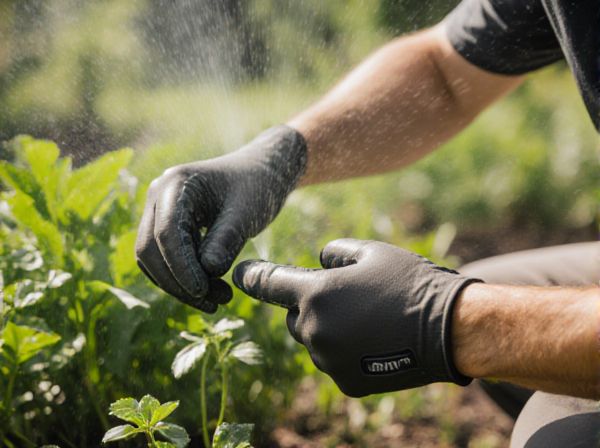
Drip Irrigation vs Overhead Sprinkling Illustration
Drip irrigation delivers water directly to plant roots with minimal evaporation and runoff, enhancing water efficiency and promoting healthier plant growth. Overhead sprinkling covers larger areas but often results in water wastage through evaporation and runoff, making it less efficient in arid conditions. Selecting the appropriate system depends on plant types, soil conditions, and water conservation goals in landscaping projects.
Table of Comparison
| Feature | Drip Irrigation | Overhead Sprinkling |
|---|---|---|
| Water Efficiency | High - delivers water directly to plant roots, minimizing evaporation and runoff | Moderate - water loss due to evaporation and wind drift |
| Installation Cost | Higher initial cost due to tubing and emitters | Lower initial cost with simpler setup |
| Maintenance | Requires regular emitter cleaning to prevent clogging | Lower maintenance, but sprinklers may need adjustment |
| Water Coverage | Localized watering, ideal for specific plant zones | Wide-area coverage, suitable for lawns and large landscapes |
| Suitability | Best for garden beds, shrubs, and trees | Best for lawns and open areas |
| Water Pressure Requirements | Low to moderate pressure needed | Moderate to high pressure required |
Introduction: Choosing the Right Irrigation System
Drip irrigation delivers water directly to plant roots through a network of tubes, minimizing evaporation and reducing water waste. Overhead sprinkling distributes water over a larger area, simulating natural rainfall but often leading to more evaporation and runoff. Selecting the right irrigation system depends on factors such as plant type, soil conditions, water availability, and landscape design goals.
How Drip Irrigation Works
Drip irrigation delivers water directly to the root zone through a network of tubing and emitters, minimizing evaporation and runoff. This precise watering method enhances plant hydration efficiency, promoting healthier growth while conserving water. By targeting the soil surface near plants, drip irrigation reduces weed growth and soil erosion compared to overhead sprinkling.
Overhead Sprinkling Explained
Overhead sprinkling distributes water through elevated nozzles, simulating rainfall to cover large landscape areas uniformly and quickly. This method is effective for lawns and gardens requiring broad moisture coverage but tends to increase evaporation and runoff compared to drip irrigation. Proper scheduling and nozzle selection optimize water use efficiency while maintaining plant health in various soil types.
Water Efficiency Comparison
Drip irrigation delivers water directly to plant roots, reducing evaporation and runoff, which results in up to 50% more water efficiency compared to overhead sprinkling. Overhead sprinkling often leads to significant water loss through wind drift and evaporation, especially during hot or windy conditions. Studies show that drip systems can reduce overall water consumption by 30-70% in landscaping applications, making them ideal for sustainable water management.
Impact on Plant Health
Drip irrigation delivers water directly to the root zone, reducing evaporation and minimizing fungal diseases by keeping foliage dry, which promotes healthier plant growth. Overhead sprinkling often wets leaves and stems, increasing the risk of mold, mildew, and other foliar diseases that can compromise plant vitality. Efficient water use with drip systems supports stronger root development and overall plant resilience in landscapes.
Installation and Maintenance Requirements
Drip irrigation systems require precise installation with emitters placed directly at the roots, minimizing water waste and reducing soil erosion. Maintenance involves regular flushing of drip lines and checking emitters for clogs to ensure efficient water delivery. Overhead sprinkling systems demand installation of sprinkler heads at optimal heights and coverage patterns, with frequent inspections for leaks, nozzle clogs, and system pressure to maintain uniform water distribution.
Cost Analysis: Drip vs. Sprinklers
Drip irrigation systems typically incur higher initial installation costs due to specialized tubing and emitters but offer significant water savings and reduced fertilizer use, resulting in lower long-term operational expenses. Overhead sprinklers generally have lower upfront costs but lead to higher water consumption, increased evaporation losses, and potential plant disease risk, driving up maintenance and water bills. Analyzing total cost of ownership favors drip irrigation for water-efficient landscapes, especially in arid regions where water costs are substantial.
Suitability for Different Garden Types
Drip irrigation suits small to medium-sized gardens and areas with water-sensitive plants by delivering water directly to the roots, minimizing evaporation and runoff. Overhead sprinkling works well for large lawns and resilient plants, providing broad coverage but with higher water loss due to evaporation and wind drift. Gardens with varied plant types and terrains may benefit from combining both systems to optimize water efficiency and plant health.
Common Problems and Troubleshooting
Drip irrigation commonly faces clogging issues due to mineral buildup or debris blocking emitters, requiring regular filter cleaning and occasional system flushing to maintain optimal water flow. Overhead sprinkling often encounters uneven water distribution caused by nozzle clogging or wind interference, necessitating frequent nozzle inspections and adjustments for consistent coverage. Both systems benefit from routine maintenance to identify leaks, pressure inconsistencies, and damaged components, ensuring efficient landscape irrigation.
Which System is Best for Your Landscape?
Drip irrigation delivers water directly to plant roots, minimizing evaporation and promoting efficient water use ideal for gardens and drought-prone landscapes. Overhead sprinkling covers a larger area more quickly, making it suitable for lawns and large turf spaces that require even coverage. Choosing the best system depends on plant types, landscape size, and water conservation goals.
Drip Irrigation vs Overhead Sprinkling Infographic

 gardendif.com
gardendif.com